
Case Report
J Dent & Oral Disord. 2018; 4(4): 1097.
Synergetic Dental Fixed Bridges the Carlson Bridge®
Carlson R*
Carlson Bridge Technologies, Inc. Pvt Ltd, Hawaiia, USA
*Corresponding author: Ron Carlson, Carlson Bridge Technologies, Inc Private Enterprise, Hawaiia, USA
Received: March 19, 2018; Accepted: April 12, 2018; Published: April 19, 2018
Abstract
We are avid champions of the principle “first do no harm” in dental or medical treatments promulgated by Hippocrates long ago, as well as many others, and have for close to three decades researched the procedures required for the replacement of missing teeth without complicated, time consuming, invasive and costly methods. People, generally, are in a quandary as to what path to take, root canal therapy for their infected tooth or extraction, traditional tooth cutting fixed bridgework to replace a missing tooth, removable partial bridges for missing teeth, the various strategies for a quick fix snap on smile, or an implant replacement system. Most people are unaware of the simple, safe, effective, durable, and efficient alternative of the Carlson Bridge® “Winged Pontic” tooth replacement system.
Keywords: Teeth; Root canal; Fixed bridges
Introduction
Old hands in dentistry know the value they create in rebuilding dentitions (mouths) by replacing missing and broken teeth, their contributions in time and money for their patients. They are also aware of the costs of maintaining a modern dental practice on an hourly basis. This “hourly basis” is just one standard upon which dentists base their fees that work together with other expense factors and value offered/created.
Let us look at one procedure, the single tooth fixed replacement of a missing tooth, to demonstrate the synergetic impact of modern dental materials and processing times in a new fixed bridge innovation—Carlson Bridge® “Winged Pontic” Tooth Replacement Systems.
We define synergy as:
• The interaction of elements that when combined produce a total effect that is greater than the sum of the individual elements, contributions, etc.; synergism.
• Physiology, Medicine/Medical. The cooperative action of two or more muscles, nerves, or the like.
• Biochemistry, Pharmacology. The cooperative action of two or more stimuli or drugs.
This principle in life, synergy, is observable in this true life example: during World War II, the search for lightweight, superstrong, durable and easily worked with metals for the production of airplanes was of prime importance. What scientist found in trial and error chemical structuring of metals such as iron, steel, cobalt, aluminum, etc., was that often the strengths of the end products combined were 5 to 10 time greater than expected. They anticipated a result that might have been expected of a tensile strength 10,000 lbs. / inch2. ; but, what resulted from this combination was 100,000 lbs./ inch2.
Baffled by this the aerospace industry termed this phenomenon synergy as they called upon “Bucky” for clarification. R.B. Fuller (Bucky) wrote about this extensively in his book SYNERGETICS published in 1975. Other scientific researchers called it “doing more with less or more with less-ing.”
We meet with “synergy” every day of our lives little aware of its profound impact. In a sense Synergy is Creativity, the act of experimentation and thoughtfulness as to a vision of a much better service we may offer the dental patient. We present this principle, synergy, as observed in the profession of dentistry as demonstrated in Table 1.
Removable flipper
Traditional bridge
Dental Implant
Carlson Bridge®
Cost
~$1,740.00
~$4,500.00
~$6,400.00
~$1,600.00
1. No. of Visits
3-Feb
5-Mar
20-Dec
1-Jan
2. Definitive Result
No
Yes
Yes
Yes
3. Approx. Lifespan
6 mo.—1yr.
3—5yrs.
?
3—5yrs.
4. Tissue Altered
Little
Yes
Yes
None
5. Completion time
1—2 Weeks
About 1 month
6mo.—1 year
One Day
6. Time in chair
1 hour
3—6 hours
5— 15 hours
1 hour
7. Expected pain
No
Moderate to High
Moderate to High
No
8. Needed meds
No
Yes
Yes
No
9. Easily modified
No
No
No
Yes
10. Shade modified
No
No
No
Yes-Anytime
11. Laboratory Costs
Yes
Yes—High
Yes—Very High
None
12. Stress Doctor
Very little
Very High
Very High
Little/ Moderate
13. Galvanic Current
(Clasps) -2-3uA
(Metal) -3-12uA
(Tit.)-30–200uA1
None
14. Stress Patient
Little
Moderate/High
Very High
Little / None
15. Death Threat
None
Moderate
Moderate to High
None
Table 1: Single Tooth Synergetic Replacement Comparison [1-3].
What Carlson Bridge® Technologies has shown since 1999 that a fixed dental bridge of very high standards and quality can be done in as little as an hour with restorative dental composites of superior structure without internal fiber support as proposed by many companies, and a new conceptioning [4-10].
Case Presentation
An 82year old man split tooth #12 and came to us to correct his missing tooth issue. He had heard of our tooth replacement process and wanted it done rather than extensive tooth reduction for a traditional bridge or implant placement for a crown. His physical condition prohibited long sessions in the chair since he had spinal scoliosis.
In view of his requirements we accomplished the following steps as demonstrated in the Figures as follow in one hour.
In Figure 1 a missing left first premolar, tooth #12 is seen. The prefabricated “Winged Pontic” is seen in Figure 2 having been adjusted for the edentulous space.
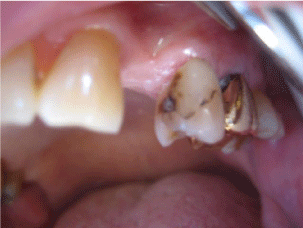
Figure 1: Pre-op showing slight decay on mesial of #13 with a cervical
composite restoration on the facial aspect.

Figure 2: The “Winged Pontic” is shown after fitting into the edentulous area.
Figure 3 shows occlusal relationships of the prefab “Winged Pontic,” trimmed and adjusted into the space between the support teeth without attachment composite affixed.
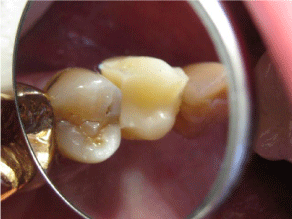
Figure 3: Occlusal view of loose fitting “Winged Pontic”.
The line of placement is confirmed as the “Winged Pontic” is adjusted to flow in and out of the space easily.
Figure 4 shows the “Winged Pontic” first premolar #12 with attachment composite applied to the proximal surfaces ready for insertion between #11 and #13, but only after preparation of the support teeth #11 and #13 for decay and surface cleanliness.
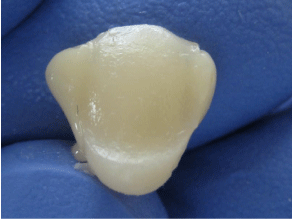
Figure 4: “Winged Pontic” prepared for installation with soft composite on
proximals.
After treating the enamel of support teeth #11 and #13 with etchant, water cleaning and drying, old existing composites are silanated with Carlson Bridge® © RS CARLSON DDS 3
“Winged Pontic” Bond Enhancer and then a coat of clear resin and attachment composite are applied to proximal surfaces seen in Figure 5.

Figure 5: Once Proximals of #11 and #13 are readied, the “WP” is installed.
The prefab “Winged Pontic” (Figure 4) has first been etched for 30 seconds, cleaned with water, next treated with the CB® “WP” Bond Enhancer, clear resin is applied, followed by attachment composite application to proximal surfaces as seen in Figure 4. The “Winged Pontic” is now ready for insertion between the support teeth seen in Figure 5.
The prefabricated, pretreated “Winged Pontic” is carried to the space and inserted as seen Figures 5 and 6 in the predetermined line of draw. The attachment composite is smoothed over all aspects of the pontic and support teeth and then light cured. The “Winged Pontic” is layered over with finishing composite, if needed. This is a time when creative artistic skills may be applied. Once cured, the occlusion is checked and adjusted in all excursions. Various flame shaped finishing diamonds are used for characterization. Final polish may be done with fine finishing diamonds 25 micron and 50 micron, and rubber wheels.

Figure 6: Once full insertion complete curing takes place and adjusting
begins.
Final results are demonstrated in Figures 7 and 8.
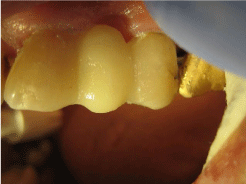
Figure 7: Final adjusting and polishing of the Carlson Bridge® “Winged
Pointic.”
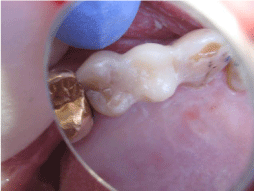
Figure 8: Occlusal view of the finsihed composite bridge.
Our Possible Futures
This process, the Carlson Bridge® “Winged Pontic” tooth replacement system may open doors to new possibilities in the way dentists practice [11-13]. Biosynthetic tissue engineering seems to be the leading edge in dentistry today, but only as an adjunct to other technical procedures carried out in the dental office, such as implants, flippers, or
traditional porcelain veneer bridges. Resin composite materials are the closest to dentine and enamel in their strengths witnessed by their flexural modulus, compressive strengths and wear capacities
With this new methodology, it may also be a pleasant experience for the patient who can shorten his or her time in the dental chair and come away with an immediate dental cosmetic enhancement. Additionally, it will not create a financial burden or, require extensive healing time or unnecessary oral discomfort.
It is also beneficial to the dental practitioner since the procedure is shorter in duration, therefore physically less demanding, less complicated in that intricate tooth preparations are unnecessary, and ultimately more rewarding creatively, artistically and remuneratively.
Conceivably a well trained dental hygienist or dental assistant could complete this tooth replacement in less complicated and challenging areas. Overseen by the dental surgeon, the fixed bridge results would be ensured as to strengths, dynamics of occlusion and esthetics. This may in the future be a norm for some practices in maintaining his or her viability in the market place of dentistry facing growing “corporate dentistry” and the general changes in our society relative to finance, productivity and profit.
As with the new restorative composite systems of direct composite restorations the “Winged Pontic” prefab system offers a choice for the doctor and the patient regarding complex treatment plans and procedures. In this day and age of limited dental health budgets, it is an idea whose time has come.
In senior populations health issues as well as costs are a major consideration in replacement of missing teeth. We have perfected the methodology for a one appointment, minimal time in the chair, direct composite bridge we identify as the Carlson Bridge® “Winged Pointic” tooth replacement system for one or more missing teeth [13].
We present this short article with the intention of encouraging others to use this non-invasive, artistically satisfying and relatively inexpensive system not only for seniors, special needs people, but in young and middle age people as well.
References
- Gittens RA, Olivares-Navarrete R, Tannenbaum R, Boyan BD, Schwartz Z. Electrical Implications of Corrosion for Osseointegration of Titanium Implants. J Dent Res. 2011; 90: 1389-1397.
- Valle A, Zanardini E, Abbruscato P, Argenzio P, Lustrato G, Ranalli G, et al. Effects of low electrical currents (LEC) treatment of pure bacterial cultures. J Appl Microbiol. 2007; 103: 1376-1385.
- Palmer SB. “SECONDARY” DECAY, The Dental cosmos; a monthly record of dental science: Vol. XXII. 1880; 22: 15-21.
- Jokstad A, Gokce M, Hjortsjo C. A systematic review of the scientific documentation of fixed partial dentures made from fiber-reinforced polymer to replace missing teeth. Int J Prosthodont. 2005; 18: 489-496.
- Carlson RS. Breakthrough Dental Bridgework: The Bio-Logical Dental Bridge. Dent Today. 1999; 18: 88-90.
- Carlson RS. Dental Artistry General Dentistry. The Peer-Reviewed Journal of the Academy of General Dentistry. 2003; 51: 4.
- Carlson RS. Cap it? Or Wrap it? Dentistry Today. 2009; 28: 74-75.
- Belvedere P, Turner WE. Direct Fiber-Reinforcement Composite Bridges. Dent Today. 2002; 21: 88-94.
- Knight JS, Whittaker DA. A new look at chair-side fiber reinforcement of resin composite. Gen Dent. 2003; 51: 334-336.
- Carlson RS. Immediate Post-Extraction In Situ Direct Lamination Composite Bridge. Dent Today. 2006; 25: 116-119.
- van Heumen CC, Kreulen CM, Bronkhorst EM, Lesaffre E, Creugers NH. Fiberreinforced dental composites in beam testing. Dent Mater. 2008; 24: 1435-1443.
- Bayne SC. Dental Biomaterials: Where are We and Where Are We Going? J Dent Educ. 2005; 69: 571-585.
- Carlson RS. Preformed Design Bridging Concept: A Case Report. Dent Today. 2014; 33: 124-127.